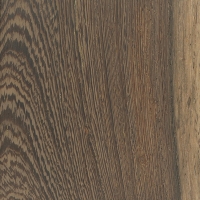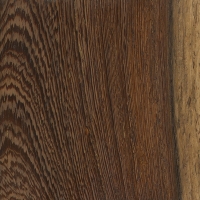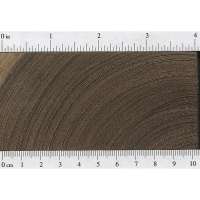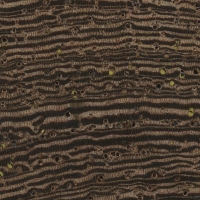 |
Common Name(s): Panga Panga Scientific Name: Millettia stuhlmannii Distribution: Eastern Africa Tree Size: 60-90 ft (18-27 m) tall, 3-4 ft (1-1.2 m) trunk diameter Average Dried Weight: 54 lbs/ft3 (870 kg/m3) Specific Gravity (Basic, 12% MC): .72, .87 Janka Hardness: 1,640 lbf (7,310 N) Modulus of Rupture: 19,020 lbf/in2 (131.2 MPa) Elastic Modulus: 2,281,000 lbf/in2 (15.73 GPa) Crushing Strength: 10,890 lbf/in2 (75.1 MPa) Shrinkage: Radial: 3.9%, Tangential: 6.6%, Volumetric: 10.5%, T/R Ratio: 1.7 |
Color/Appearance: Heartwood is a very dark brown with black streaks. Upon application of a wood finish (particularly an oil-finish) the wood can become nearly black.
Grain/Texture: Has a straight grain and a coarse texture. Panga Panga also has very large pores that can present a challenge to fill if a perfectly smooth/leveled finish is desired.
Endgrain: Diffuse-porous; large to very large pores in no specific arrangement, very few; solitary and radial multiples of 2-3; brown or yellow deposits occasionally present; medium rays not visible without lens, normal spacing; parenchyma winged, confluent, and banded (bands typically as wide as the pores).
Rot Resistance: Very durable, and resistant to termite attack.
Workability: Can be difficult to work with hand and power tools. Blunts tool edges. Can sand unevenly due to differences in density between light and dark areas. Can easily get splinters when handling this wood, which tend to go septic (see safety information below).
Odor: Panga Panga has a faint, slightly bitter scent when being worked.
Allergies/Toxicity: Although severe reactions are quite uncommon, breathing Wenge wood dust (closely related to Panga Panga) has been reported to cause central nervous system effects, irritation of the skin and eyes, and is a sensitizer. Also, Wenge splinters tend to take longer to heal and are more likely to go septic (get infected) than splinters from other woods. See the articles Wood Allergies and Toxicity and Wood Dust Safety for more information.
Pricing/Availability: Tends to be on the high side, close to other exotic tropical hardwoods such as Cocobolo or Zebrawood.
Sustainability: This wood species is not listed in the CITES Appendices or on the IUCN Red List of Threatened Species.
Common Uses: Panga Panga and Wenge can both be dark enough to be used as substitutes for ebony.
Comments: Panga Panga is very similar in working properties and appearance to Wenge, and it’s not uncommon for the two species to be used and mixed interchangeably.
 |
 |
 |
 |





What is this wood? Looks like wenge but lighter and has no pores. I put wenge on the right of the photo for example
The wood does have pores, it’s just that they are probably filled with either tyloses or mineral deposits. Do you have a shot of the endgrain? Also, where did the wood come from, or where are you located? How heavy is the wood in relation to other woods?
It turned out to be katalox! Someone suggested measure the density and you’ll know. He was right. Heavy beautiful piece!
Greening probably due to UV light, Lignum Vitae behaves the same way. You might have to re-finish and keep away from strong light.
Recently had a client asking for Panga Panga timber, which was quite popular in the past and there are number of old parquet floors made of it. However in the recent days there is pretty much no import of Panga Panga. The only available option for the British market, at the moment is to use Wenge, instead. Both wood species (as mentioned above) have very similar appearance. Some would say that they are practically identical. Perhaps the only difference is that Wenge is slightly harder.
Is panga-panga used for veneer?
Of yes, An advice to know how to produce veneer with.
afonsohelder.ah@gmail.com
Try sanding it down that would be the only way to remove that oxidation layer